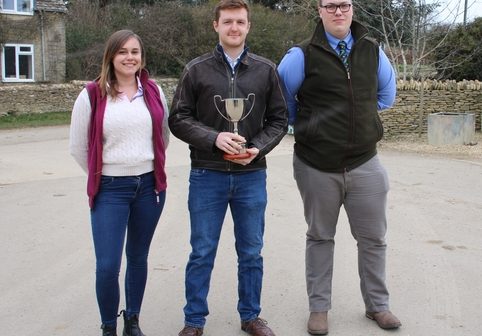A team of agriculture students from Aberystwyth University’s Institute of Biological, Environmental and Rural Sciences (IBERS) are the winners of the 2017 NIAB Agronomy Cup and the title ‘the best student wheat growers in the country’.
James Bradley, David Casebow, Anna Crockford, Rosie Francis and Hannah Hinchliffe achieved the highest gross margin of £1,402.55/ha in the annual trial plot competition, based on a yield of 11.15 t/ha and an input cost of £80.40/ha. They beat 13 other university and colleges, and a team of NIAB TAG farmer members, finally lifting the Cup at the Cirencester NIAB TAG members’ technical conference this week. A team from Easton and Otley College, in Norfolk, came second with Sparsholt College, in Hampshire, taking third place.
IBERS-Aberystwyth came close in 2016, only finishing second because of a higher fungicide spend, and were determined to take the trophy this time. NIAB TAG’s national trials co-ordinator Ian Midgley explained that the winning team’s approach was to be thoroughly prepared before making the final recommendation.
“The IBERS-Aberystwyth team took note of all the site information provided by NIAB staff, made good use of plot visits to our site at Hereford, identified the diseases present and understood the strengths and weaknesses of the competition variety. They asked many questions, clearly understood the terminology used and the basics of wheat agronomy and above all wanted to learn. It definitely paid off,” said Ian.
Captain David Casebow described the reasoning behind team’s technical recommendations. “Septoria was present in the crop when we made our first site visit to Hereford in March. By applying Bravo 500 (ai chlorothalonil) at the T0 and T1 timings we wanted to slow the spread of the disease, with Ignite (ai epoxiconazole) at T1 lowering the risk of yellow rust occurring. With KWS Siskin’s lodging resistance score of 6 we applied a full rate chlormequat at T1 and, as we weren’t aiming for the milling premium, we opted out of extra nitrogen.”
The crop was relatively clean by the April visit, although there was plenty of yellow rust and Septoria in the surrounding plots, so the team dropped the T2 Adexar (ai epoxiconazole + fluxapyroxad) rate to three-quarters. “We then recommended a T3 fungicide as KWS Siskin has some susceptibility to fusarium and other ear diseases, but chose a three quarter rate Folicur (ai tebuconazole) to keep the costs down,” said David.
The winning 2017 NIAB Agronomy Cup crop recommendation
| Treatment | NIAB standard | IBERS-Aberystwyth |
| Early N | As farm crop | As farm crop |
| T0 | Cherokee @ 1.0 l/ha | Bravo 500 @ 1.5 l/ha |
| T1 | Tracker @ 1.0 l/ha + Bravo 500 @ 1.0 l/ha | Bravo 500 @ 2.0 l/ha + Ignite @ 0.75 l/ha |
| T2 | Adexar @ 1.5 l/ha | Adexar @ 1.5 l/ha |
| T3 | Folicur @ 0.75l/ha | Folicur @ 0.75 l/ha |
| T0 PGR | chlormequat @ 1.25 l/ha | None |
| T1 PGR | chlormequat @ 1.0 l/ha | chlormequat @ 2.0 l/ha |
| Late N | None | None |
Across the six NIAB competition sites the highest treated yield was 12.27 t/ha (103% of site standard), achieved at Morley in Norfolk by Easton & Otley College. Morley also achieved the highest untreated yield at 11.0 t/ha. The highest fungicide spend was £157.15/ha but the plots only out yielded the NIAB standard £92.08/ha spend by 0.1 t/ha. The lowest untreated yield was on the Devon site with 8.44 t/ha with the best fungicide programme on the site providing a yield increase of 40%.
Plots are already ready and waiting for the 2018 competition entrants with the competition opening up to Young Farmers’ Clubs teams for the first time this year. Application forms for available to download from www.niab.com or on application from Ian Midgley at NIAB.




